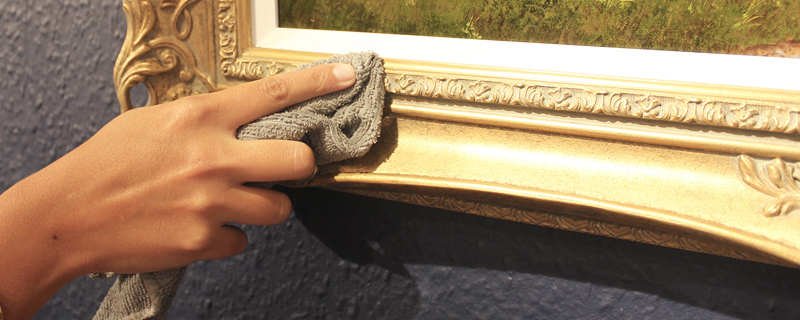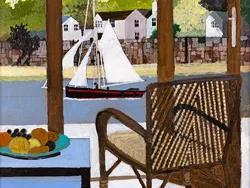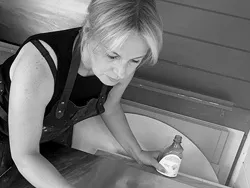To ensure that your painting remains in good condition, we have put together this guide for the basic cleaning and maintenance of oil paintings. Extensive cleaning and restoration should always be carried out by a trained art conservator; but with care, routine maintenance can be performed at home to keep your painting in its best possible condition.
Canvas and panel paintings must be treated with the utmost care. Due to skin's natural oils, it is advised that you never touch the front of a painting with bare fingers.
General Cleaning
The frame may be wiped with a slightly damp cloth, or carefully vacuumed with a brush accessory. A brush accessory may also be used to clean the back of paintings on both canvas and panel.
The painting itself will also require cleaning to remove any surface dust or dirt. If the dust is light, use a clean, soft-bristled paintbrush to gently brush away any visible accumulation. Always use a new paintbrush, as any residual solvents on the brush can damage the paint. For heavier dust, dampen a soft, lint-free cloth and gently wipe the surface of the painting. The cloth must be a new, lint-free cloth, as any shedding will catch on the paint. It is also recommended that distilled water be used to dampen the cloth, as tap water may contain small quantities of chlorine or minerals. Under no circumstances should you ever apply any cleaning products to the surface of the painting.
When cleaning a canvas painting, avoid overly flexing the canvas, as this can potentially crack or dislodge flakes of paint. Paintings with flaking paint should be left untouched to avoid dislodging flakes completely. In the unlikely circumstance that flaking occurs, contact the gallery immediately for assistance.
For extensive cleans of older paintings, restoration services are available. Please contact the gallery for details.
Storage and Display
Temperature
Rapid changes in temperature can cause the canvas or panel to quickly expand and contract as it heats and cools. Over time, this can potentially cause paint to crack and flake, the canvas to sag or the panel to split. As such, it is recommended to display your painting in an environment where the temperature remains fairly stable, ideally no more than approximately 21° C. Particularly for paintings on panel, if at all possible, try to avoid places that experience rapid temperature change (i.e. directly over radiators, fires or wood-burning stoves, uninsulated lofts, etc.).
Relative Humidity
In addition to temperature, relative humidity also has a significant effect on the condition of a painting. In a similar reaction to changes in temperature, a canvas or panel will also expand and contract as it absorbs or releases moisture. If an environment is too dry, it can make a canvas or panel brittle, making it more likely to crack or split. On the other hand, too much moisture can facilitate its own problems, such as mould and mildew. While best practice in museums and galleries aims for approximately 50% relative humidity, the average homeowner is not likely take such a rigorous approach. But at the very least, avoid hanging paintings in or near bathrooms, kitchens, damp walls or exterior vents, and be aware of how factors like air conditioning and central heating can influence an environment’s humidity.
Light
Over prolonged periods of exposure, both natural and artificial UV light can cause significant damage to paintings. While true that a new painting will not require the same extent of protection as an antique one, by taking preventative measures from the beginning, you can help to preserve the good condition of your painting for generations. Professional best practice recommends limiting light exposure to 150-200 lux for oil paintings, and 50 lux or less for watercolours or other paintings on paper. As such, avoid hanging your painting in direct sunlight, and utilise curtains or blinds to reduce the amount and extent of UV light that your painting receives. If using a picture light or other artificial lighting, consider using LED rather than tungsten or fluorescent bulbs, as LED bulbs do not emit UV light.
Tightening the Canvas
Over time, the canvas of your painting may begin to ripple or sag as a result of the temperature and humidity of its environment. In many cases, this may be fixed with a simple tightening of the canvas.
Begin by placing the painting face down onto a firm, level surface where the frame cannot be scratched. On each corner of the stretcher bars, you will note two small wedges. Place a piece of card under these wedges and slide it slightly under the stretcher bar to protect the canvas throughout the tightening process.
Using a small hammer, lightly tap each wedge two times. Remove the card and place it under the next set of wedges and as before, tap each of the wedges two times. Moving around the canvas in a clockwise direction, follow this same procedure until each set of wedges has been tapped twice.
Once you have tapped all of the wedges, lightly drum the back of the canvas with the back of your finger. The canvas should be taut, but less so than a drum. If it is not, repeat the process using only one tap for each wedge until the canvas reaches the desired tightness.
If you have difficulty tightening your canvas or have any questions, please contact the gallery for assistance. Please note that this guide has been put together in good faith and York Fine Arts cannot be held responsible for any damage to artworks or persons.




